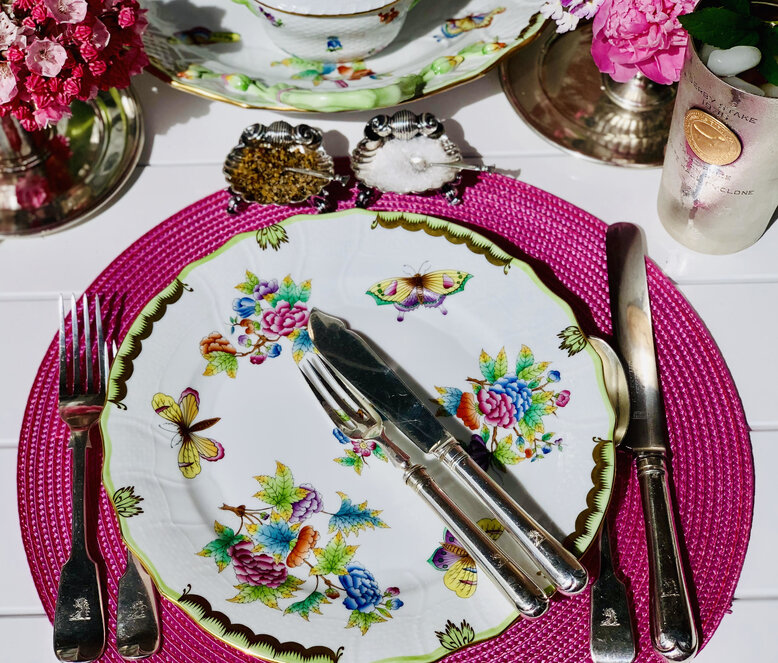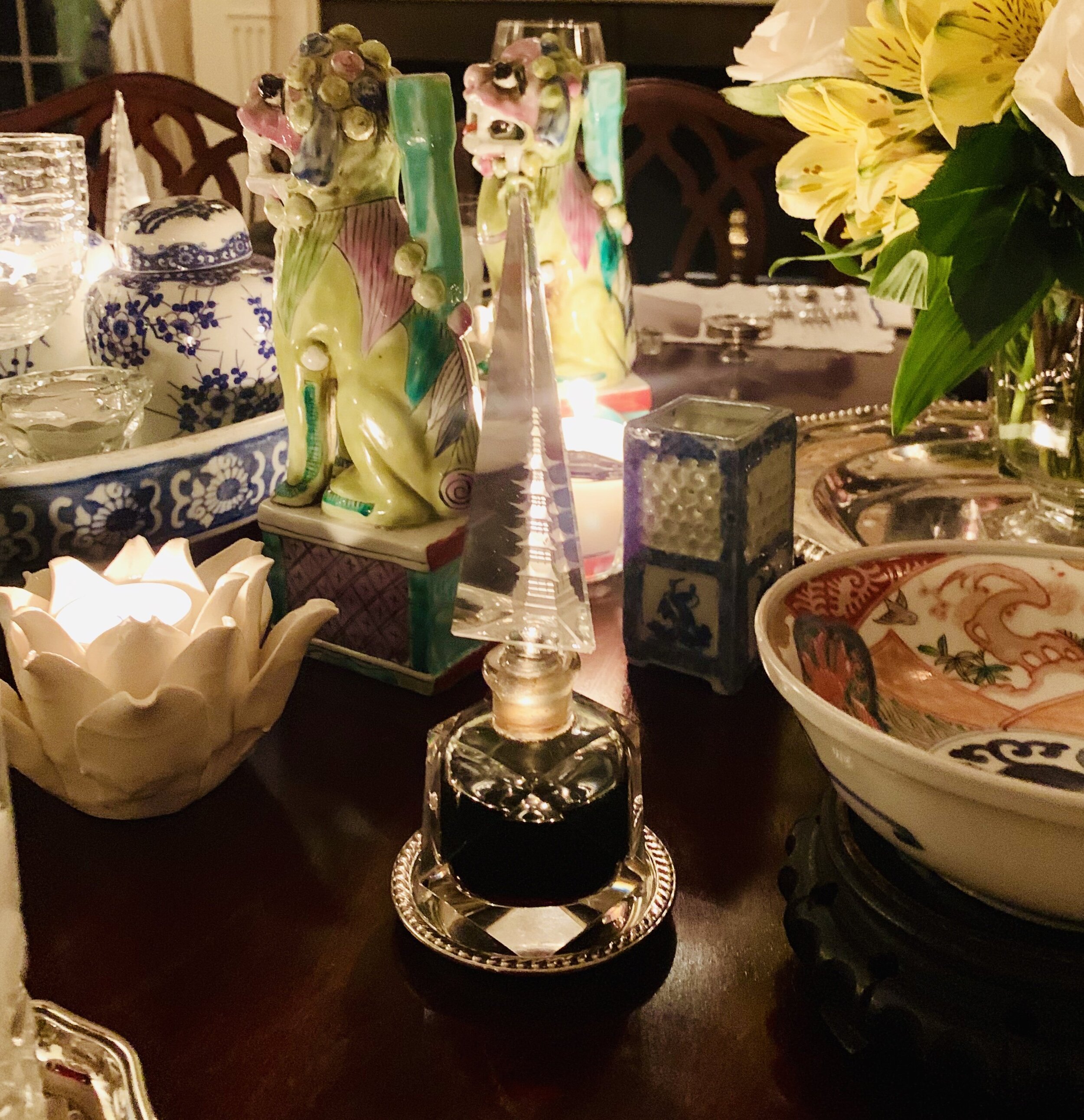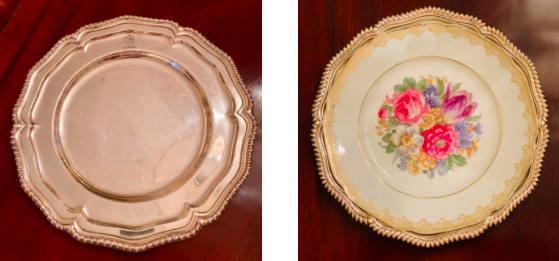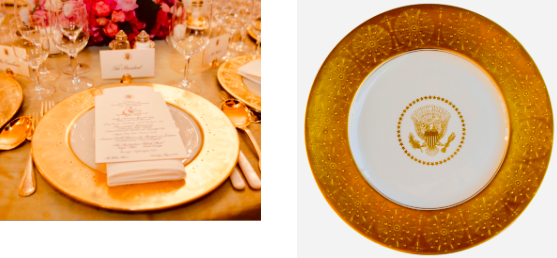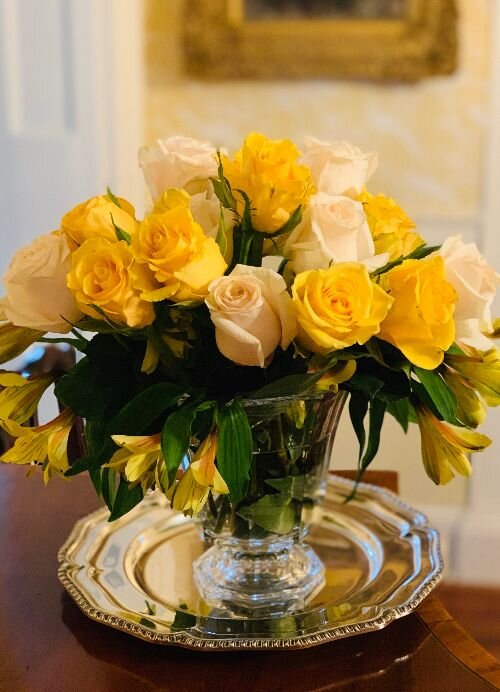A few examples of place card holders that I have collected through the years, along with two place settings at elegant dinner parties that my husband and I have attended. For more place card holder options, consider our new sponsor: Scully & Scully.
A place card (or seating card) tells a guest where they will be seated at the table. Guests appreciate place cards, and they also admire little place card holders! The name on a place card faces the guest. A place card may be tented (folded at the top) which does not require a place card holder, or not tented, and flat, which requires a place card holder. Place cards, in place card holders, may be arranged above the dinner plate centered on the place setting or placed above the forks. A place card may lie flat, without a place card holder, and placed in the center of the service plate, or on top of the napkin.
An escort card, also called a table card, is used to direct guests to their table, but not their actual seat. It will have the name of the guest on the outside of the envelope, and the table number indicated on the card inside the envelope. Arranged in alphabetical order, the cards are typically placed near the entrance of the dining room. Originally, an escort card shared the name of a lady guest (indicated on the card) with a gentleman (name on the envelope) who would then escort her into the dining room or reception.
The place card indicates the seat placement for the guest. If there is not a place card present, the guests may choose where they wish to be seated at their appointed table.
Married couples may be on the same table card: Mr. and Mrs. R. Stuart Holden. A family may be listed on one table card if they are all seated at the same table: The Holden Family.
Place cards and escort cards need to be legible! They may be handwritten, or done by a calligrapher, or printed out on a printer. If you are in a quandary over how to spell someone's name, reach out to the guest, before the event, and confirm how to spell their name correctly.
The paper color and design are the same for both the table card (or escort card), the place card and the menu card.
For business functions, a tented card may be larger than a regular place card. It may have the person's name printed on both sides so that others sitting at the table can also see whom they are addressing at the meeting.
Sign up for Mummy’s Monday Manners to receive new sparkling tips about etiquette and classic design every week, along with a free download of Holly’s Elegant Entertaining e-book.
Forbidden Faux Pas
No-no: To move a place card to a different seating location!
Guests sometimes forget how much time and effort has been exerted by the hosts to orchestrate the perfect placement of their guests. Remember to be respectful of where you have been selected to be seated. Once seated, if someone has a hearing issue, or has a reasonable request to the other guests at the table as to why they wish to change their seat, of course, that is acceptable.
No-no: To write "Guest" on a place card or escort card.
What is done: If you do not know the name of a guest or the escort's name, make an effort to find out what it is!
Millennial Tip
Guests want place cards! As the host and hostess, you are running the show. With place cards, there is no confusion when your guests enter the dining room as to where they will be seated. I think it adds to the joviality of the party knowing that you have been chosen to be seated in a particular place, and adds to the excitement for each guest when entering the dining room to find out where their place card is located. The hosts have given much thought as to whom and where each guest will be seated. Enjoy discovering why you were chosen to be near the guests around you!
The old adage, "six seats itself" is true and there is no need for place cards for an intimate dinner for six. The host indicates to the lady guest of honor to be seated to his right, while the hostess indicates for the gentleman guest of honor to be on her right, and then the other two guests can easily see where to sit.
Start collecting paper place cards, along with attractive place card holders. When you discover darling place card holder sets, at an auction or in a shop, begin to collect them with a theme or color scheme in mind. By having a set more significant than 12, or by owning another set that complements the place card holders you already own, you may sprinkle them interchangeably on the dinner table when hosting a more substantial function!
My husband and I have attended formal dinner parties where the children or grandchildren of the hosts have made the place cards out of construction paper, colored in a design or added gold stickers, which adds a most charming, personal touch to the table.


